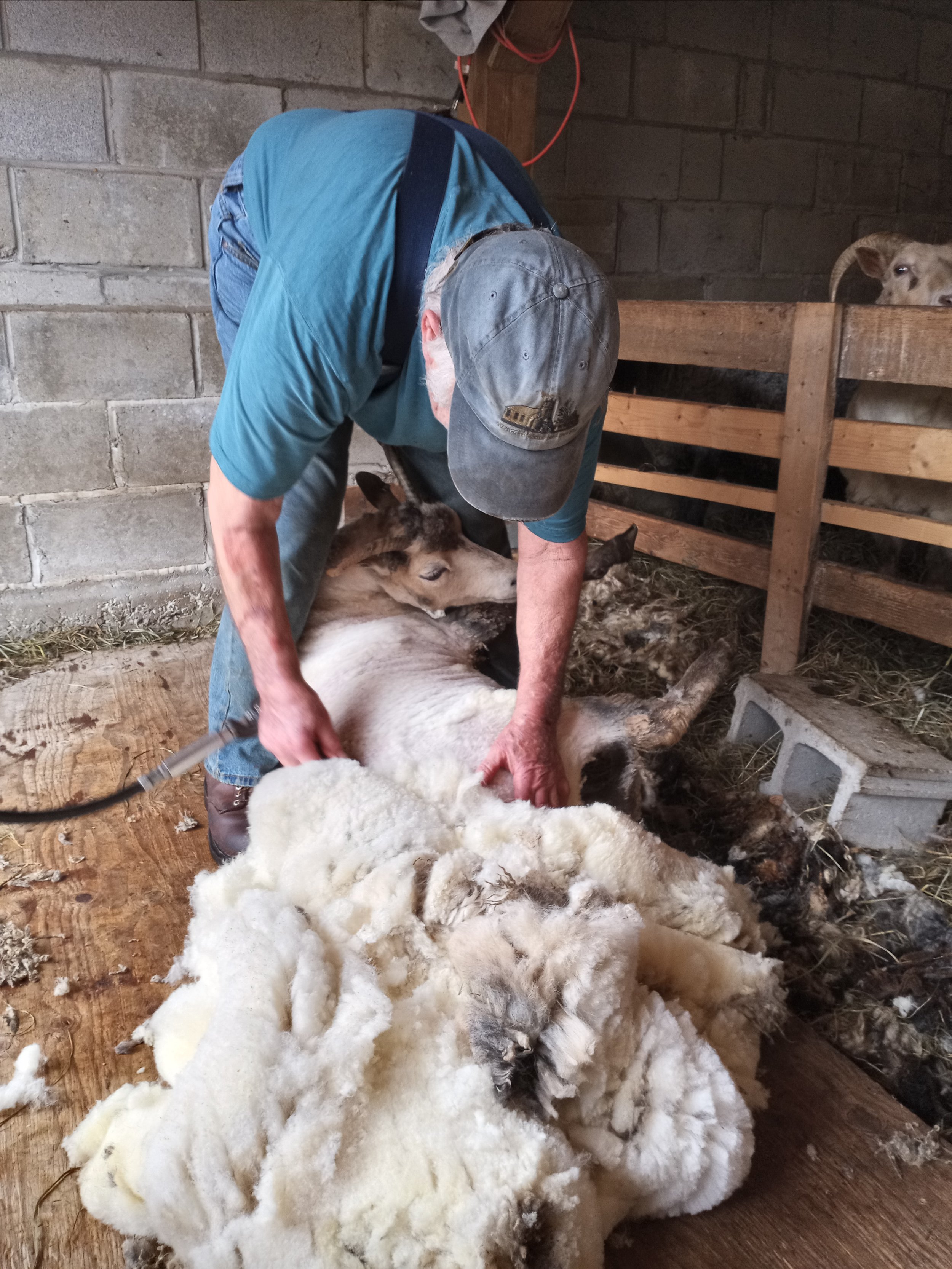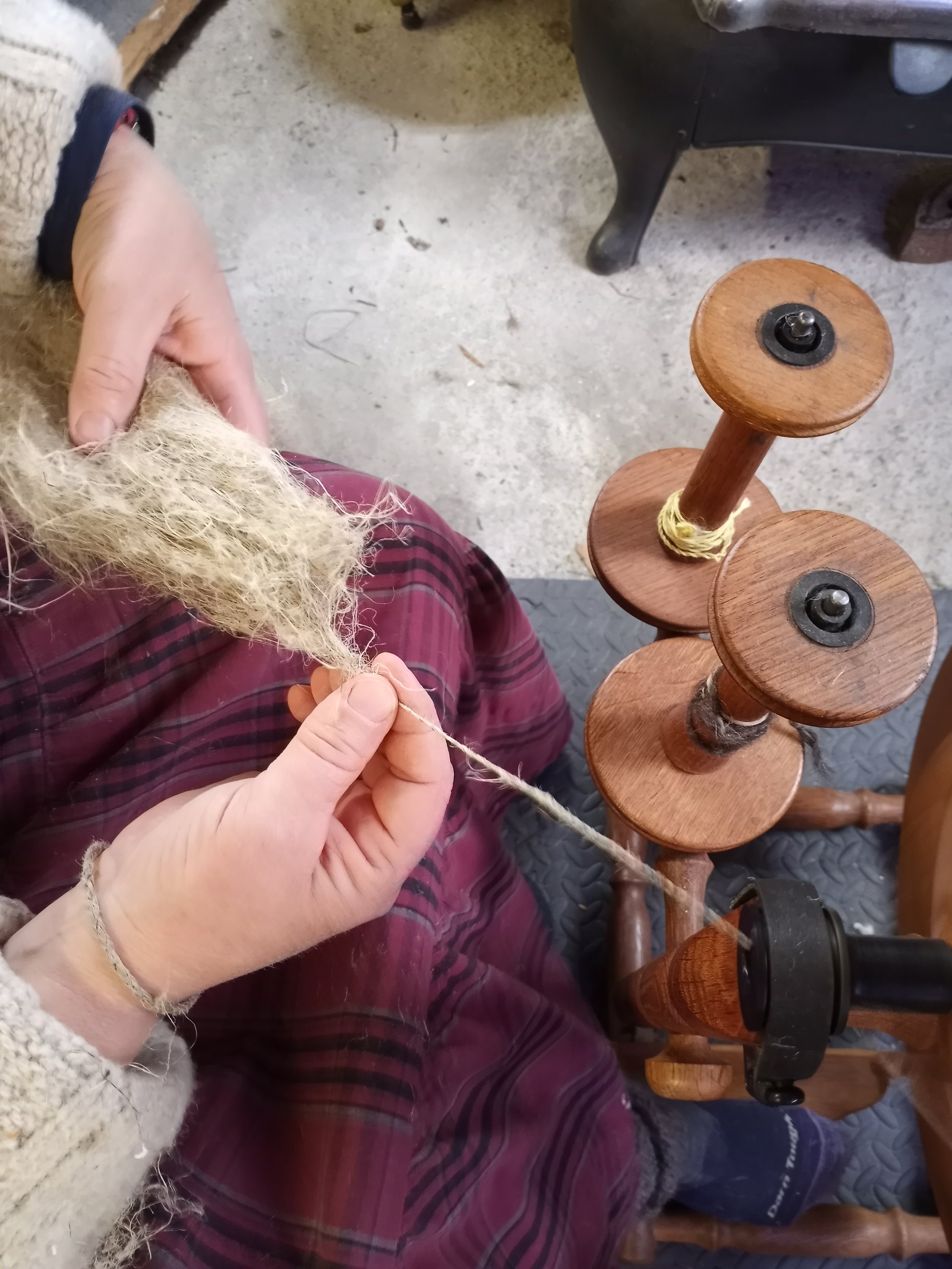Springtime: sheep shearing, spinning, and planting season
A couple weeks after the heavy snow, springtime has come.
Spring has arrived in earnest and we completed the process of sheep shearing several weeks ago. The weather was rainy in the days leading up to our April 15 shearing date, and I closed the entire flock (40 sheep) into the barns a couple of days before our shearer, Fred Depaul, arrived. Everyone was a bit damp despite my efforts, and in the week after the sheep got their haircuts, I spread the fleeces out in the sun to finish drying.
Iris, a freshly shorn Icelandic sheep, looking a bit sandwiched between Ergo and Facto, two of my Romney ewes.
The legendary Fred Depaul finishes our day with a haircut for Rose, an Icelandic X Shetland ewe.
I found that I had an unusually high amount of felted wool on some of the fleeces this spring, which I suspect was caused by the record-breaking wet summer we had in Vermont last year. Still, a lot of beautiful wool, including the fleeces from the ewe lambs born last spring. I typically send about a hundred pounds of wool off to the mill I work with to be processed into roving in yarn (in recent years I have worked with Battenkill Fibers and the Junction Fiber Mill for processing), but I still have quite a bit of inventory left from last year’s clip, so I’m hoping to sell more of the 2024 fleeces as raw wool.
Skirting a Shetland lamb’s wool. Below, a full fleece on the skirting table.
The grass is finally growing here, and the flock is looking forward to getting onto fresh greenery for the season. The change in rhythm is welcome, as the farmwork shifts from interior projects and the barns to outdoor landscape and planting tasks.
As winter receded and spring began, I hand spun a number of hemp fiber samples for my friend and colleague, Laura Sullivan, in support of her hemp research at the University of Vermont. These samples represent plots grown with different seeding rates and harvest dates, and I spun both line and tow fibers. It felt great to take a deeper dive into these materials, as it dovetails with my own fiber hemp research work, just getting underway. For more about Laura’s very interesting work, check her out on Instagram at @hempfiber.artistfarmer.
Spinning carded hemp tow.
Hemp tow fibers hand processed on a drum carder.
Some of the samples after scouring and re-skeining.
Detail of a handspun hemp yarn.
I have been busy getting processing/work spaces ready for my own research work here at the farm. I have raw and retted fiber (both hemp and flax) left from the crops I grew last year at Smokey House Center. I have moved some of this material into one of my barns here at Mountain Heart, and a bunch of last year’s Bialobreszkie and Futura 83 hemp is presently retting in a tank and on the grass around the farmhouse. The second floor of my small barn is a seasonal workspace where I have spinning equipment and several of my looms.
Retted samples from last year’s crops awaiting further processing.
Setting up the summer studio. I have seven looms set up at the moment, but I’m the only weaver. I should try to remedy this!
Outside, we’ve been preparing my little research field for planting. This field is about .25 acre/11,000 square feet, and has been used as pasture for the sheep for the past four years. I will continue to give the sheep access to this field during the winter, so we are creating fencing that will permit this. Given its small size, we prepped the field by first raking/forking up areas where there was a thick layer of fallen hay, and then ran a heavy rototiller over it. We will till it once more before planting it, which I am hoping will happen during the week of May 13, weather and seed shipments permitting.
Fieldwork in progress. A portion of the field at the right of the image is not in use this season, as a new septic drainfield will be installed later this summer.
I’ll be planting fiber hemp, flax, indigo, and broom corn in this field in 2024. The hemp varieties include Futura 83 and Bialobreszkie, being grown for UVM’s ongoing research work. My SARE grant is focused on dioecious varieties (with roughly equal numbers of male and female plants in a population), because I want to better understand the potential for obtaining fine, long line fiber from the male plants, and will be harvesting them separately from the female plants.
It’s been a challenge sourcing small quantities of dioecious seed. A lot of current industrial hemp research emphasizes plants with a lot of biomass (heavier stems, very tall, and feminized or monoecious crops), which is not necessarily what I am interested in exploring (in a future blog post, I’ll try to talk a bit more about what I’ve been reading about historic hemp linen production in Europe and Asia, and provide some links to online sources for more information).
I will be planting Carmenecta hemp from King’s Agriseed, Tiborszallasi from Northeast Heritage, and a variety called “Zaki” from the USDA Germplasm Bank housed at Cornell.
The indigo is also part of my grant project, as I will be using it for side-by-side comparisons of the effects of using retting water for irrigation. The broom corn is being planted as part of my rotational plan for this small field. Also, I love ornamental broom and broom-making!
My primary flax plot (about a 30’ x 60’ plot this year) will be Avian. I have smaller quantities of other varieties I am growing out for seed, including Linore, Callista, Melina, and Lisette.
I am hoping to plant all of these crops with a new seeder I acquired this spring, A Jang JP-1 single row seeder. I’m aware of others using this seeder successfully with flax seed, and I’m hoping that it will also work for hemp. I just used the word “hope” twice in as many sentences - that seems both like a good place to stop writing, and an expression of every farmer and gardener’s state of mind in springtime.
The handsome Jang seeder.
Ready for action.
Endings and beginnings
Springtime snow at Mountain Heart Farm, late March, 2024
All the snow of the winter has fallen in the last two weeks, and I’m feeling anxious for spring to arrive.
It’s been a season of stark contrasts, marked by the deaths of animals old and young, and the arrival of new life in the form of surprise lambs and a new puppy.
Sen, the old border collie, in his usual spot with his best friend, a 19-year-old cat named Shadow, a few days before he died
We said goodbye to our elderly rescue dog, Sen, who died peacefully in his sleep with his good cat friend curled up beside him. He was born into difficult circumstances, and he was never quite a ‘normal’ dog, but he was a good one, and we were lucky to be his family.
The new puppy, Marlowe, is a tri-colored smooth collie, just over 3 months old. He is full of the puppy energy I had forgotten, and has made friends with Rollo the cattle dog, who has been helping him to quickly learn the ropes around the farm. The cats are reserving judgement for now.
Young Marlowe
We also sadly said goodbye to several of the elderly sheep in the flock over the winter months, including Rain, Cooper, and Gwynn. At about 15 years old, Cooper was quite old, and had been a beloved member of the flock for many years. A big Dorset wether, he was raised as a bottle baby and was very friendly with people. Coop once performed in a commercial, for which he was a consummate professional, flawlessly hitting his marks over multiple takes. I still find myself looking for his huge body out in the pasture, towering over the rest of the flock, and listening for his distinctive bellow.
Our other winter loss was a young ram named Mullet, who died of complications from wethering surgery. He was a beautiful, friendly, black Shetland x Romney, and had spent the winter free-ranging the front yard, separated from the ewes. Or so I thought. While I was still mourning his unexpected loss, the first of an unknown number of surprise lambs arrived.
Baby Ninja, mom Leia, and the back end of baby Noodle - Surprise!
Sleeping in the sun between snowstorms
Baby Nimbus with Lachnta
Clearly, my plan to keep the ewes away from young Mullet has failed. I hadn’t planned on doing any lambing at all this season, but the flock had other plans, and I confess, I’m glad that Mullet had a chance to pass on some of his genes in the flock. We’ll see how many more lambs arrive in the coming weeks.
Textile flax, 2023
Fiber hemp at Smokey House Center, 2023
Since 2020, I have been growing flax (and last year fiber hemp) at the nearby Smokey House Center here in Danby. In the fall of ‘23, I wrote a USDA SARE Farmer Grant to expand upon some of the fiber hemp research work I did there for UVM, and was pleased to learn earlier this winter that my grant has been funded.
In many ways, this work is building upon an earlier, flax-based SARE grant I completed shortly before moving to Vermont. In addition to a plot of textile flax (Avian this year), I will be growing multiple varieties of fiber hemp, and working with some very knowledgeable technical advisors from UVM and Cornell.
Antique and contemporary hemp textiles, and a hemp line fiber sample from the 2023 season
Watch for future blog posts about this work, which will include selective harvesting of male and female plants for long line fiber quality, variety trials, retting experiments, and using retting water as a fertilizer for dye plants. I hope that the work I’ll be doing contributes to the development of a new regional infrastructure of natural textiles, healthy materials, and green building products.
After a lot of consideration, I made the decision to move this ongoing and new bast fiber research from Smokey House to my home farm, Mountain Heart. I’m grateful for my time growing at SHC, where staff old and new supported my work and helped to shape the research questions I am exploring now.
There’s a lot of work to be done to get ready for springtime tasks, including sheep shearing this month, and the preparation of planting beds for flax and hemp research.
If it would just stop snowing…
Bluebird sky. Dorset Peak. So much snow.
























